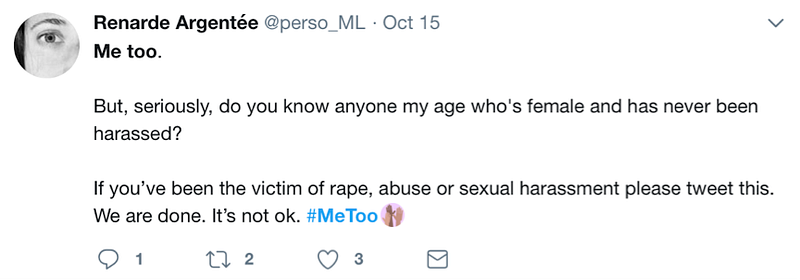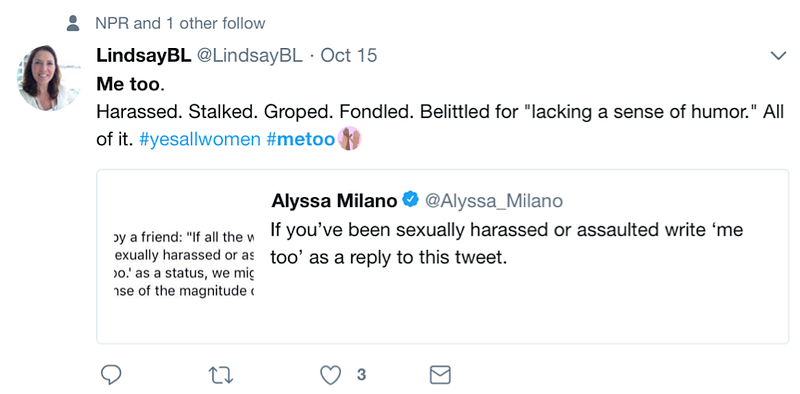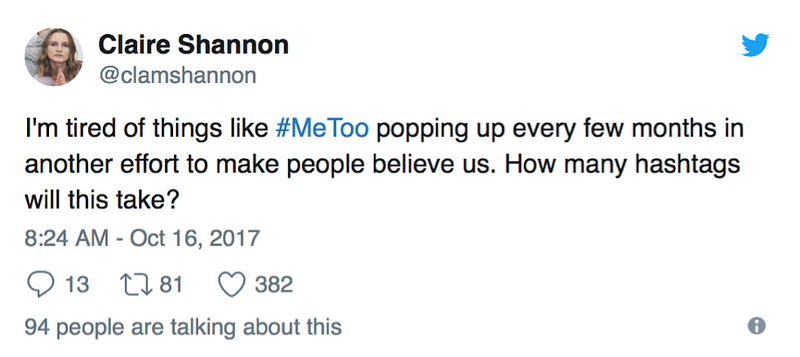#MeToo is being named the TIME’s Person of The Year for 2017. It has been called a moment with the potential for a movement, a ‘cultural reckoning’ and a full-blown movement.
To understand the role #MeToo has played, we can turn to posts on Twitter. It certainly isn’t a movement in itself — it is an incredibly valuable tool of a movement that is in its nascent stages. So, why was it chosen as Person of the Year? What has it achieved? An interesting way to understand #MeToo is by saying it is an exhumation process, borrowing from Diane Nelson.
I recently read her book “Who Counts: The Mathematics of Life and Death After Genocide” where she describes the gruesome exhumations in Guatemala after the civil war. During the war, community members knew only of things that happened in their own village. Once the exhumations began, each unearthed skeleton put together, identified through DNA testing and placed in context gave meaning to words like “a lot” — it gave us the exact number of people killed and told us who they were and how they were killed.
Numbers, in fact, played an important role in understanding how systematic the violence was. The statistics that came to light, Nelson reminds us, led to the ruling against Riot Montt. There are many differences — in gravity, intensity and historic situation — but the parallels between these exhumations and the tales unearthed through #MeToo are numerous: the evidence of violence — both psychological and physical, the isolated experiences of the individuals, the focused visibility of power, and the revelation that it was more common than ever expected.
MeToo has been a two-level exhumation: First, it has been a digging up of old memories. Users took instances that were brushed aside, labeled “it is what it is” and re-categorized them as “this is not okay.” This is where the work began. The second exhumation is when this recovered memory surfaced on someone’s Twitter, Facebook, Instagram or lips as a hashtag.
#MeToo began with an awareness agenda, intent on counting the number of victims. Numbers, as we have observed, have played an important role in the ‘public trials’ of perpetrators. Initially, when the hashtag was gaining momentum, every user declared their intent, echoing Milano’s original tweet:
“If all the women who have been sexually harassed or assaulted wrote ‘Me Too’ as a status, we might give people a sense of the magnitude of the problem.”
In addition to counting, the hashtag performed other important functions. It has unearthed: the shocking frequency of incidents, stories that when read together reveal the range of sexual misconduct, and the fact that these incidents and the perpetrator’s identities are common knowledge among victims in their social groups.
It’s not one man or woman — it is systematic. For years, we have put up with it. These tweets [some of the many] refer to this already existing knowledge of the frequency of harassment and abuse:






The other important work that this hashtag has done is help us see ‘what counts’ as sexual misconduct, through stories and snippets of experiences that shed light on the quality of the encounter, the age of the user and events that preceded and followed it:









#MeToo also involved a lot of self-reflexivity. We asked questions about the hashtag means, who it’s reaching and what kind of effect it’s having in the real world, including who has the power to speak up [primarily cis white women], who is heard and what the victims have to do to be believed.
This meant that the story #MeToo was telling about itself was not just cohesive, but also subject to change as its goals evolved from awareness to a fight for justice:




So, it has been named person of the year. People are more aware of how power operates in every industry, at every level. Is this exhumation process over?
Clearly, no. The stories we have heard come from a particular demographic. What about those that have not felt the effects of this ‘cultural reckoning’, specifically women of color?
Optimistically, one would hope the exhumations continue and having achieved significant awareness, this person of the year continues working next year and moves its goal to accountability of the perpetrators, an overhaul of policy enforcement in workplaces, pay more attention to less glamorous fields like journalism, silicon valley and academia, and by examining patterns in the stories, uncovers the “persuasion architecture” of these systems.
At its worst, one can hope that the remains are not reburied under newer media agendas, slipping back into a new negotiated ground of ‘it is what it is,’ remembering that ‘this is not okay.’





![Social alienation is a sharp tactic in the toolkit of domination [although, here it is the extension of female subordination]. Photo by Hans Van Den Berg/ flickr.com](https://b-change.me/wp-content/uploads/2018/01/1sTnAkZgJEx1Yb6fctMyVuA-570x300.jpeg)




